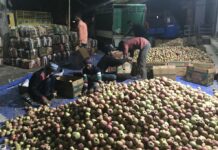Raise in milk production has brought in prosperity for some villages in Pulwama giving their children access to education and a better life. Mir Farhat reports.
Early morning Nazir Ahmad Gori, 47, leaves his home with two cylindrical steel canes for collecting milk in three neighboring villages – Pathan, Uthoora and Tengpora, to sell it in Srinagar during the day. He has been doing this work for last 31 years. Nazir’s father was also a milkman. In their Talangama village in south Kashmir’s Pulwama district, 20 of the 120 households earn a living by collecting and selling milk.
Nazir was studying in class 8th when he started helping his father in the business. “I left studies and helped my father in collecting milk in the neighbouring villages,” recollects Nazir. “This was and is our only source of income.”
 Nazir wants his all three children to be educated. “I could not study beyond 8th but I want my children to study higher,” says Nazir. His elder son Mudasir is 26-years-old. He has been helping his father in collecting milk but his father didn’t allow him stop studying.
Nazir wants his all three children to be educated. “I could not study beyond 8th but I want my children to study higher,” says Nazir. His elder son Mudasir is 26-years-old. He has been helping his father in collecting milk but his father didn’t allow him stop studying.
He has done master’s degree in English literature. “This is our source of income with which we could afford our schooling,” says Mudassir. “I will continue collecting milk if I get a job.” Each family in the village rear cows. Nazir has six. He, however, says that the rising prices of fodder were affecting rearing of cattle.
Farooq Ahmad Gori is a young man of 28 years old of the same village. He has been collecting milk for more than a decade. Three years ago Besides Ahmad established two cheese manufacturing units in the village. He employs 10 persons.
Collecting and selling milk, he says, was not enough to feed and take care of their large family of 18. “It (milk collecting) did not improve our living. So I established these two units,” says Ahmad. “In these two units we manufacture about 1000 kilograms of cheese and sell it only in Srinagar and Kishtwar.” None of the milkmen families in the village own any agricultural land and their only occupation is milk collecting. About 150 men from these families work as milkmen. These men collect about 3,000 liters of milk from the neighboring villages and sell it in Srinagar.
Earlier, for the villagers education was never a priority as the families were poor. However, collecting and selling milk has brought some amount of prosperity. The White Revolution, project in India had envisaged raising milk production. The local cows were crossbred with high milk yielding varieties like Jersey, Friesian and Holstein. Pulwama district is one of the success stories of the white revolution in Kashmir.
“This belt produces about 20,000 litres of milk besides 1000 Kilograms of cheese every day,” said Dr Rafiq Naqshbandi, District Animal Husbandry officer, Pulwama.
Now every family has at least one person who has studied up to higher secondary. “Majority of students in the village drop out in 12th class. Just five persons have done post graduation in different subjects,” says Mudassir.
In another village, Manduna, which is half a kilometer from Talangaum, about 20 families, who are all farmers, have found a lucrative business in milk collecting. This village produces 3000 liters of milk and engages about 20 persons in collecting it.
Wali Muhammad Bhat is 54-year-old and belongs to a farmer family. He is the first person among the farmers who went into collecting and selling milk in 1982. Although, Muhammad owned agricultural land but it was not enough to feed his four children and wife. Wali Muhammad says that paddy land only provided food but no money. “I found it (milk collecting) easier and lucrative than daily wage labour,” he says.
Muhammad says that he collects about 50 liters of milk every morning in his village and in other neighboring village and then sells it in Srinagar. “It provided me enough money. I purchased more land. All my children had an education and it helped me marry off two of them.”
The occupation of milkman carries a stigma among the farmers’ community. Muhammad’s son, Zahoor Ahmad Bhat, unlike Gori’s does not want to carry on with this occupation. “I will study and find some other job,” says Zahoor.
Besides, his father also does not want his children to work as milkmen. “I was illiterate so I did it. My sons should not do it,” says Muhammad. Muhammad recounts that one person (he did not tell his name) among the farmers could not get married as he “worked as a milkman”.
In addition to these two villages, three other villages – Sanzvatroo, Trich and Naroo – in the Pinglen belt, are major producers of milk and it engages more than 100 persons in it and feeds about 80 families.
The prosperity brought to the area was the result of the thrust on enhancing milk production under Operation Flood, which was a rural development programme started by National Dairy Development Board (NDDB) in 1970.















